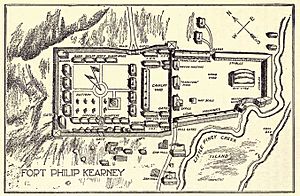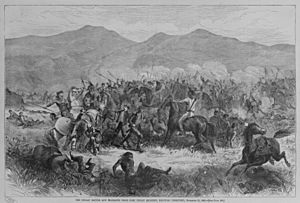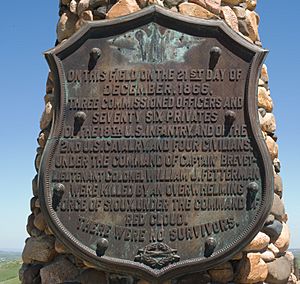Red Cloud's War facts for kids
Quick facts for kids Red Cloud's War |
|||||||
|---|---|---|---|---|---|---|---|
| Part of the Sioux Wars | |||||||
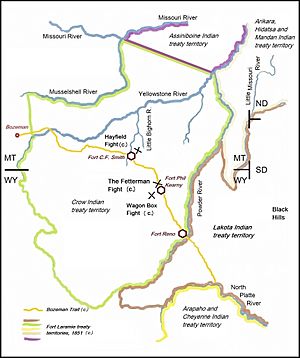 Battle locations |
|||||||
|
|||||||
| Belligerents | |||||||
| Commanders and leaders | |||||||
|
|||||||
| Strength | |||||||
|
1,500–2,000 | ||||||
| Casualties and losses | |||||||
| ~200 killed | Unknown | ||||||
Red Cloud's War was a fight between a group of Native American tribes and the United States. It happened in what is now Wyoming and Montana from 1866 to 1868. The war was also known as the Bozeman War or the Powder River War.
The main reason for the war was control over the western Powder River Country. This area was important for hunting and living. The Native American side included the Lakota, Northern Cheyenne, and Northern Arapaho peoples. They were led by chiefs like Red Cloud.
In 1863, American settlers created the Bozeman Trail. This trail went right through the lands of the Cheyenne, Arapaho, and Lakota. It was the quickest way for miners and settlers to get to the Montana gold fields. Many people used the trail, which caused problems. They competed with the Native Americans for food and other resources.
The United States named the war after Red Cloud, a respected Oglala Lakota chief. The U.S. Army built forts along the trail to protect travelers. They said they had a right to do this because of a treaty. These forts were actually in Crow Indian territory. The Crow people helped the U.S. Army, believing it would protect their interests.
Red Cloud's War mostly involved small attacks by Native Americans. They raided soldiers and civilians at the forts. This wore down the soldiers. The biggest fight was the Fetterman Fight. In this battle, 81 U.S. soldiers were killed. It was the worst defeat for the U.S. Army on the Great Plains until the Battle of the Little Bighorn ten years later.
The war ended with the Treaty of Fort Laramie in 1868. The Lakota and their allies won. They gained control of the western Powder River country. The forts were taken down, and the Bozeman Trail was closed forever. The Crow people lost their hunting grounds in this area. This victory for the Lakota lasted only eight years. Then, the Great Sioux War of 1876 began, and the U.S. started taking their lands again.
Contents
Why Did Red Cloud's War Happen?
The Powder River area was important to many tribes. The Crow people lived there first. They were known for living near the Yellowstone River and its branches.
The Lakota people had been moving west for a long time. By the early 1800s, they controlled a large area. In 1820, Lakota and Cheyenne warriors attacked a Crow camp. This made them enemies. In 1843, an explorer named John C. Frémont heard that the Lakota planned to take Crow land. They wanted the Crow's good bison hunting grounds.
The 1851 Fort Laramie Treaty
In 1851, the U.S. made a treaty called the Fort Laramie Treaty. This agreement set boundaries for different tribes. The goal was to create peace among them and protect settlers. Many tribes signed it, including the Crow, Lakota, Cheyenne, and Arapaho. Tribes often fought each other for land and resources. These fights continued even after the treaty.
As hunting became harder in the 1850s, the Lakota expanded their hunting grounds. They ignored the 1851 treaty boundaries. They crossed the Powder River, which was the border with Crow land. They started taking land from other Native groups. The Crow people fought back against the Lakota. By 1860, the Lakota and their allies had pushed the Crows out of their hunting grounds west of the Powder River.
The Bozeman Trail's Impact
In 1863, gold was found in Bannack, Montana. This made white settlers look for an easier way to get there. John Bozeman and John M. Jacobs created the Bozeman Trail. It went from Fort Laramie through the Powder River country. This trail passed through lands that the Lakota had recently taken from the Crow.

In 1865, the U.S. Army sent the Powder River Expedition to fight the Lakota, Cheyenne, and Arapaho. This expedition had many soldiers but failed to defeat the Native Americans. Instead, it made them more determined to resist.
After this, the U.S. tried to make peace. They negotiated treaties with some Lakota, Cheyenne, and Arapaho leaders. These treaties offered money if the Native Americans would leave the trails alone. However, many important leaders, like Red Cloud, were not part of these talks. They did not agree with the treaties.
Talks at Fort Laramie
Negotiations between Native American leaders and the U.S. began in June 1866. On June 13, Colonel Henry B. Carrington arrived at Fort Laramie. He had about 1,300 soldiers and supplies. His orders were to build forts in the Powder River country.
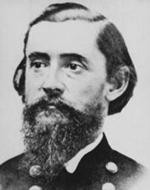
The next day, Carrington showed up at the negotiations. Red Cloud saw this as a sign that the U.S. was not serious about peace. He and other leaders left the talks and went back to their lands.
The U.S. continued talks with other Native American leaders. They offered a lot of money each year. But Native Americans knew the U.S. often did not keep its promises. The U.S. government thought the treaty would bring peace. However, at the same time, Carrington's soldiers were already under attack at Fort Phil Kearny.
The agreement was never fully approved. The U.S. could only truly negotiate about the Powder River lands with the Crow tribe. They were the rightful owners according to the 1851 treaty.
The Two Sides of the War
Carrington left Fort Laramie for the Powder River Country on June 17, 1866. He had about 700 soldiers and 300 civilians, including families. They also had many wagons and cattle. This force was smaller than previous U.S. expeditions.
Most of Carrington's soldiers were new and were infantry (foot soldiers), not cavalry (horse soldiers). They had older rifles from the Civil War. These rifles were slower to load than newer ones. Carrington was an engineer, not a combat leader. He focused on building strong forts. His officers, many of whom were Civil War veterans, wanted to fight. They did not understand how Native Americans fought.
Carrington did not use Native American scouts. These scouts could have given him important information. Scouts from other tribes had helped the U.S. Army in the past.
The Native American warriors had many advantages. They were mobile, skilled horse riders, and knew the land well. They used hit-and-run tactics. They could also gather many warriors for a fight. However, they were not as organized as the U.S. Army. They also had few guns and little ammunition. Their main weapon was the bow and arrow. While deadly up close, bows had a shorter range than the soldiers' rifles.
The War Begins
Carrington's group reached Fort Reno on June 28. They left some soldiers there. On July 14, Carrington founded Fort Phil Kearny near present-day Buffalo, Wyoming. Later, on August 13, they built a third fort, Fort C. F. Smith, on the Bighorn River. Building forts so late in the year was difficult because of the harsh winters.
On July 16, some Cheyenne chiefs visited Carrington. They said they wanted peace. But that same day, two white civilians were killed. The next day, Red Cloud's warriors attacked. They stole 175 horses and mules from the fort. Soldiers chased them but could not get the animals back. Two soldiers were killed.
On July 20, warriors attacked a wagon train. They killed two people. After more attacks, almost all civilian travel on the Bozeman Trail stopped. Fort Kearny could only get supplies with heavily guarded wagon trains. Native Americans often attacked wagons cutting timber for the fort. Between July and September, 6 soldiers and 28 civilians were killed near Fort Kearny.
The Fetterman Fight
In November 1866, Captains William J. Fetterman and James Powell arrived at Fort Phil Kearny. Fetterman had a lot of combat experience from the Civil War. But he did not know much about fighting Native Americans. He disagreed with Carrington's careful approach. Fetterman reportedly boasted he could ride through the Sioux nation with only "80 men."
On December 6, Red Cloud's warriors attacked a group protecting a wood train. An officer named Horace S. Bingham was killed when he chased the retreating Native Americans. Carrington worried about his officers chasing decoys (warriors trying to trick them).
On December 21, 1866, the wood train was attacked again. Carrington ordered a relief party. Captain Fetterman asked to lead it, even though Captain Powell was supposed to. Fetterman took 80 men, including two civilians with powerful rifles.
Carrington said he told Fetterman not to cross Lodge Trail Ridge. This was a dangerous area where help from the fort would be hard to get. But Fetterman ignored the order. He chased a small group of Lakota warriors, including Crazy Horse, over the ridge.
On the other side, about 1,000 to 3,000 Native American warriors were waiting. They had set a trap. The soldiers had no escape. None of the 81 men survived. The fight was not seen from the fort, but loud gunfire was heard.
The soldiers died in different groups. The cavalry charged ahead. The infantry, with older rifles, fought from cover until their ammunition ran out.
This battle was called the "Battle of the Hundred Slain" by Native Americans. Soldiers called it the "Fetterman Massacre." It was the U.S. Army's worst defeat on the Great Plains until the Battle of the Little Bighorn almost ten years later.
After the Fetterman Fight
After the Fetterman Fight, a civilian named John "Portugee" Philips rode 236 miles to Fort Laramie for help. He rode through a blizzard and freezing temperatures. He arrived on Christmas Day, delivering the message that Fort Kearny needed help.
General Cooke, who was in charge, replaced Carrington. New soldiers arrived at Fort Kearny in January. Carrington left the fort with his family. Many of his escort suffered from frostbite in the extreme cold. General Ulysses S. Grant also replaced Cooke. Investigations into the Fetterman Fight happened, but no one was officially blamed.
The Native Americans separated into smaller groups for the winter. Fighting stopped for a while. The soldiers at Fort Phil Kearny had a very hard winter. Food was scarce, and many horses died. Plans for a winter attack were canceled. In April, Native Americans began raiding along the Oregon Trail.
The Native American threat also worried the government because of the Transcontinental Railroad being built. The Army did not have enough soldiers to protect both the railroad and the Bozeman Trail.
Hayfield and Wagon Box Fights
In late July 1867, the Lakota and Cheyenne planned two attacks. One group attacked Fort C. F. Smith. Another, mostly Lakota, attacked Fort Phil Kearny. The Crow people, who lived near Fort Smith, warned the soldiers about the attacks.
Importantly, the soldiers at Fort Smith had new, faster-firing rifles. These rifles could shoot 8 to 10 times per minute, much faster than the old ones. This meant soldiers could reload quickly and stay behind cover.
On August 1, 21 soldiers and 9 civilians were cutting hay near Fort Smith. Several hundred Native American warriors attacked them. The Americans took cover behind logs and in rifle pits. They fought off many attacks with their new rifles. Two soldiers and one civilian were killed. The Native Americans lost more.
The next day, the Wagon Box Fight happened near Fort Kearny. Twenty-six soldiers and 6 civilians were cutting wood. They took shelter inside a corral made of 14 wagon boxes. Hundreds of warriors attacked. The Americans, also with new rifles, held them off for six hours. Three Americans were killed in the corral.
These fights discouraged the Native Americans from large-scale attacks. But they continued to harass the forts. On August 7, they even attacked a Union Pacific Railroad train far from the Powder River Country. This alarmed the U.S. government.
The Treaty of Fort Laramie
Even with military successes, the U.S. government wanted peace. Building the transcontinental railroad was more important. The Army did not have enough soldiers to protect both the railroad and the Bozeman Trail. It was also very expensive to keep soldiers in the Powder River Country.
Peace talks began at Fort Laramie in spring 1868. Red Cloud refused to meet until the Army left the forts in the Powder River area. In August 1868, U.S. soldiers left Fort Phil Kearny, Fort C. F. Smith, and Fort Reno. The day after they left, Native Americans burned the forts. The Bozeman Trail was closed forever.
Red Cloud finally arrived at Fort Laramie in November. He signed the Treaty of Fort Laramie of 1868. This treaty created the Great Sioux Reservation, which included the Black Hills. This reservation covered all of South Dakota west of the Missouri River. The treaty also said the Powder River country was "unceded Indian territory." This meant it was a reserve for Native Americans who did not want to live on the new reservation. It was also a hunting reserve for the Lakota, Cheyenne, and Arapaho.
The treaty was important for the Crow tribe too. To give the Lakota the Powder River area, the U.S. had to buy it from the Crow first. The Crow tribe was the original owner according to the 1851 treaty. So, the U.S. also negotiated with the Crow. On May 7, 1868, the Crows agreed to sell large parts of their land to the U.S. This included the western Powder River hunting grounds. The Crows also agreed to move to a smaller reservation.
What Happened Next?
The Lakota's control over the Powder River country lasted only eight years. The Great Sioux War of 1876 began then. This war also happened in areas that the Lakota had taken from the Crow.
After 1868, Red Cloud lived on the reservation. He saw that the U.S. would eventually overpower the Native Americans. So, he focused on fighting for fair treatment for his people. He became an important leader during the time when Native Americans moved from their traditional way of life to living on reservations. Red Cloud lived until 1909. He was buried on the Pine Ridge Reservation.
The U.S. soldiers killed in the 1866 Fetterman Fight were later reburied at the U.S. National Cemetery at Little Bighorn Battlefield National Monument.
See also
 In Spanish: Guerra de Nube Roja para niños
In Spanish: Guerra de Nube Roja para niños


